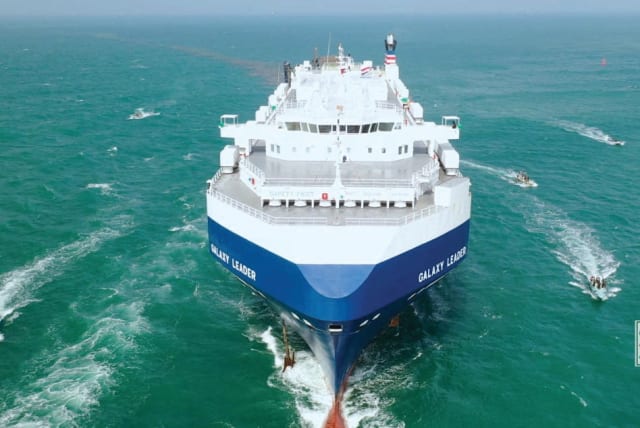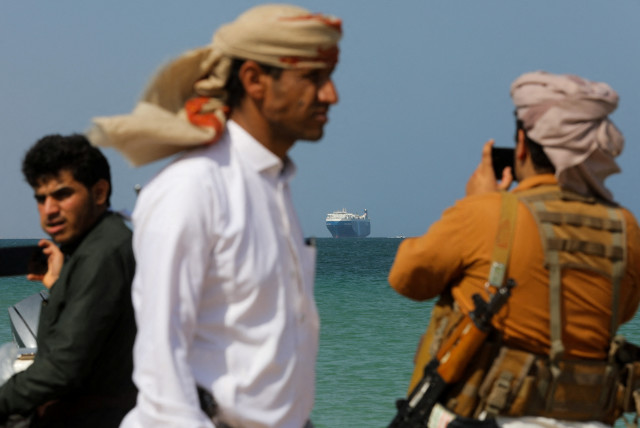Iranian-backed Houthis intensify provocations in the Red Sea - analysis

When is an attack not an attack?
The Yemeni Ansar Allah (Houthis) movement this week continued its attacks on shipping in the Red Sea and Gulf of Aden. The organization fired ballistic missiles at three ships in the Red Sea on Sunday, according to a report in the Associated Press.
The USS Carney, a US Navy destroyer deployed in the area, downed three drones during the assault. The USS Mason, according to a statement by deputy Pentagon press secretary Sabrina Singh, had “at least one ballistic missile heading toward it.” The Houthis took responsibility for two of the attacks.
Brigadier-General Yahya Saree, military spokesman for the Houthis, linked these events to Israel’s war against Hamas in Gaza. “The Yemeni armed forces continue to prevent Israeli ships from navigating the Red Sea (and Gulf of Aden) until the Israeli aggression against our steadfast brothers in the Gaza Strip stops,” he said, in a statement quoted by AP.
Preventing navigation in the Red Sea
“The Yemeni armed forces renew their warning to all Israeli ships, or those associated with Israelis, that they will become a legitimate target if they violate what is stated in this statement.”
A press release from US Central Command following the attacks noted: “We have every reason to believe that these attacks, while launched by the Houthis in Yemen, are fully enabled by Iran.”
The incidents on Sunday, December 3, were the third time that the USS Carney has downed drones in the Red Sea area since October 7. On October 19, it took down 14 drones. On November 29, it intercepted an Iranian Samad-3.
The ongoing aggression by the Houthis against shipping in this area, alongside the more than 70 attacks on US installations in Iraq and Syria, and the widening Lebanese Hezbollah missile fire on targets in Israel constitute the effort made by Iran to assist its Hamas client in Gaza.
Analysis until now has tended to dismiss these activities as “noises off,” intended to distract from the real action in Gaza. After an initial concern that the October 7 attacks might be about to herald a generalized mobilization of the Iran-led regional alliance against Israel (the much-discussed “unification of the arenas”), the general trend has been to conclude that since no such all-out assault took place, the war was one to be fought between Israel and Hamas.
The Iranians, to refute accusations that their “axis of resistance” had been revealed as a phrase without content, would carry out occasional minor provocations. The US naval presence in the Gulf and the Mediterranean would prove sufficient to deter these from escalating beyond a certain point. Thus, the dimensions of the current conflict would be limited to the Israeli-Palestinian sphere, and broader Middle East instability avoided.
THIS WOULD be a positive outcome from the US administration’s point of view for several reasons. Smaller conflicts are obviously preferable to larger ones. More broadly, the goal of normalization with the Iranian regime, which has been a clear objective of the Biden administration since its commencement, evidently remains in place.
The administration spent nearly two years in a fruitless effort to revive the Iran nuclear deal. On November 14, a month into the Gaza war, Biden extended a sanctions waiver allowing Tehran to access $10 billion in electricity revenue held in escrow accounts. The waiver permits Iran to continue purchasing electricity from Iraq.
It is worth recalling that this decision took place at a time when Iranian proxy militias were already engaging in near-daily attacks on US forces in Iraq and Syria. It indicates that the October 7 attacks – and the subsequent activities of Hezbollah, the Iraqi Kataib Hezbollah, and the Houthis – have not altered the administration’s core view or objectives regarding Iran.
But containing the war in Gaza without damaging US deterrent capacity depends on the volume of Iranian activity remaining below a certain level. Get beyond this level, and it seems like far from containing the Iranians, the US has begun to ignore clear acts of aggression out of a desire to keep the war in Gaza within its boundaries west of the Jordan River, at almost any price.
The attacks on US positions in Iraq and Syria have met with a limited response. The Iraqi Kataib Hezbollah organization, behind the banner of the “Islamic Resistance in Iraq,” is responsible for the bulk of attacks on US forces in these areas. Five members of the organization were killed in a US strike as they prepared a drone attack on US forces on Monday.
THE HOUTHI attacks in the Red Sea and the Gulf of Aden, however, represent a more significant challenge, at least for as long as the attacks in Syria and Iraq fail to result in fatalities.
The Bab el-Mandeb Strait, between the Gulf of Aden and the Red Sea, is a vital strategic waterway. Every day, six million barrels of crude oil and refined petroleum products pass through it. Around 9% of total seaborne traded petroleum flows through the Bab el-Mandeb.
US spokespersons have studiously avoided concluding that US ships were the targets of the Houthi attacks this week, since any such conclusion would imply the need for retaliatory action. Pentagon deputy press secretary Singh stumbled on her words at the press briefing last week as she sought to explain why ballistic missiles heading toward a US ship did not necessarily constitute an “attack.”
A December 4 report in Politico quoted unnamed US officials as expressing frustration at the extent of what they described as the “deliberate downplaying” of the events and the threat they represent.
The article directly quoted one unnamed official as saying: “People are thinking this is an Israel thing, and because they are heavy-handed in Gaza no one is saying anything. The world should be condemning this.”
Charles Lister, an analyst at the Middle East Institute, in a tweet, quoted sources at the Defense Department as saying that the White House is placing “every possible handcuff” on the US’s ability to respond to the attacks.
If such statements reflect the reality, then it becomes clear that the US administration is, at present, holding on to a strategy that is no longer fit for purpose. Disruption of a vital strategic waterway is not only, or mainly, an Israeli problem. If it continues, it is set to impact oil prices, and therefore the global economy.
More fundamentally, the US’s role as the guarantor of global energy routes is placed into question by the current escalation of attacks.
As to whether the US administration will shift its stance in response to the Houthi attacks, the days ahead will tell. But the activities of Iranian clients and proxies across the region can no longer be plausibly presented as a detail, a sideshow, or a distraction from the main event.
Jerusalem Post Store
`; document.getElementById("linkPremium").innerHTML = cont; var divWithLink = document.getElementById("premium-link"); if (divWithLink !== null && divWithLink !== 'undefined') { divWithLink.style.border = "solid 1px #cb0f3e"; divWithLink.style.textAlign = "center"; divWithLink.style.marginBottom = "15px"; divWithLink.style.marginTop = "15px"; divWithLink.style.width = "100%"; divWithLink.style.backgroundColor = "#122952"; divWithLink.style.color = "#ffffff"; divWithLink.style.lineHeight = "1.5"; } } (function (v, i) { });

